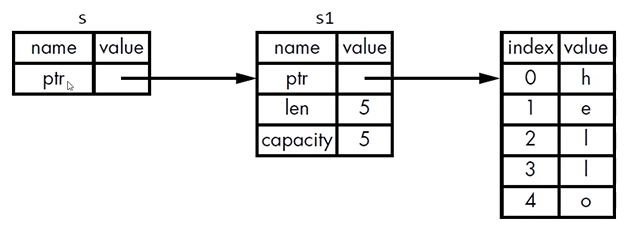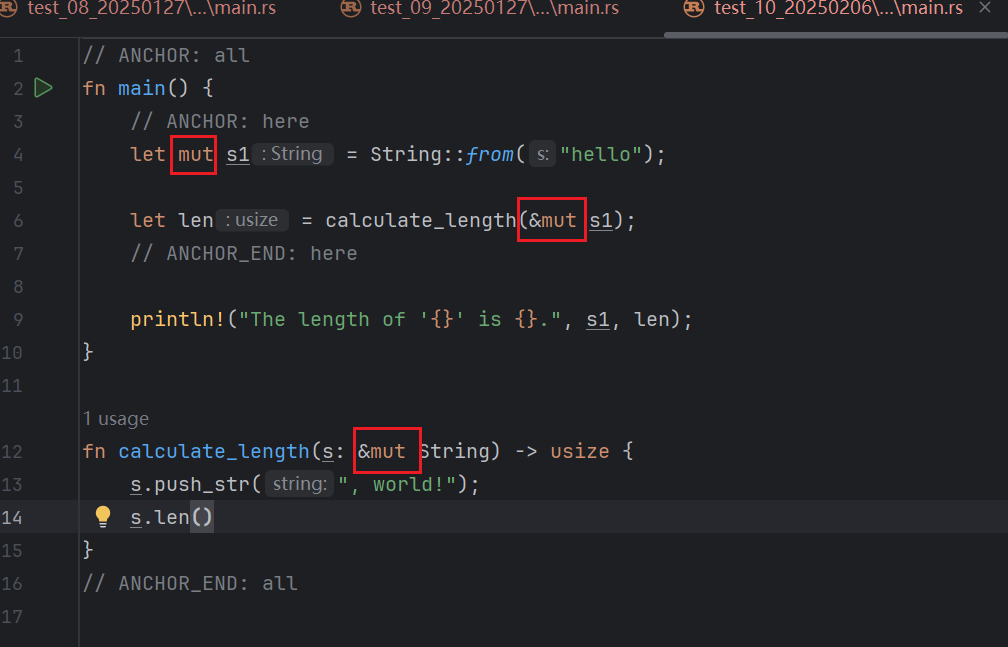# 引用与借用
# rust中引用是什么?
答:引用是一种编程上的概念。注意:概念。
# rust的引用案例
有一个函数,它能算出一个字符串的长度。并且返回的就是字符串的长度值。但不同之处是,我们没有转移s1变量的所有权。而是把s1的引用作为参数传入函数里面。注意:&的符号就表示传递的是引用。
// ANCHOR: all
fn main() {
// ANCHOR: here
let s1 = String::from("hello");
let len = calculate_length(&s1);
// ANCHOR_END: here
println!("The length of '{}' is {}.", s1, len);
}
fn calculate_length(s: &String) -> usize {
s.len()
}
// ANCHOR_END: all
2
3
4
5
6
7
8
9
10
11
12
13
14
15
上面代码解析:
calculate_length函数传入了一个引用。calculate_length函数不拥护s1,&s1所有当走出作用域时&s1指向的值不会被清理掉。
我们再看calculate_length函数的里面。这个s就是&s1的引用类型变量。calculate_length的作用域结束的时候s就出了作用域。但是s不具有指向字符串的所有权。【没有所有权】所以s指向的值不会别清理掉。
s变量区别在于不会在离开函数作用域时销毁其指向的数据。因为它没有该数据的所有权。所以当一个函数使用引用作为参数,而不是真实的值作为函数的参数的时候。我们就不必为了归还所有权把这个值返回回去。因为在这种引用的情况下我们根本没有获得这个所有权。
而这种以引用获取参数的行为:我们把它叫做 借用。
知识点总结
- 参数的类型是 &String 而不是 String。
- &符号就表示引用:允许你引用某些值而不取得其所有权。

注意:s1变量是指向了堆空间。
# rust中什么是借用?
答:借用是一种行为。
我们把引用作为函数参数这个行为叫做借用。
# 是否可以修改借用的东西呢?
答:不行。不可以修改。
案例演示:
// ANCHOR: all
fn main() {
// ANCHOR: here
let s1 = String::from("hello");
let len = calculate_length(&s1);
// ANCHOR_END: here
println!("The length of '{}' is {}.", s1, len);
}
fn calculate_length(s: &String) -> usize {
s.push_str(", world!");
s.len()
}
// ANCHOR_END: all
2
3
4
5
6
7
8
9
10
11
12
13
14
15
16

运行结果
error[E0596]: cannot borrow `*s` as mutable, as it is behind a `&` reference
--> src/main.rs:13:5
|
13 | s.push_str(", world!");
| ^ `s` is a `&` reference, so the data it refers to cannot be borrowed as mutable
|
help: consider changing this to be a mutable reference
|
12 | fn calculate_length(s: &mut String) -> usize {
| +++
2
3
4
5
6
7
8
9
10
总结:
和变量一样,引用默认也是不可变的。
# 可变引用

可变引用有一个重要的限制:在特定作用域内,对某一块数据,只能有一个可变的引用。【案例如下:】
- 这样做的好处是可在编译时防止数据竞争。
fn main() {
// ANCHOR: here
let mut s = String::from("hello");
let r1 = &mut s;
let r2 = &mut s;
println!("{}, {}", r1, r2);
// ANCHOR_END: here
}
2
3
4
5
6
7
8
9
10
上面代码执行有问题。
error[E0499]: cannot borrow `s` as mutable more than once at a time
--> src/main.rs:6:14
|
5 | let r1 = &mut s;
| ------ first mutable borrow occurs here
6 | let r2 = &mut s;
| ^^^^^^ second mutable borrow occurs here
7 |
8 | println!("{}, {}", r1, r2);
| -- first borrow later used here
2
3
4
5
6
7
8
9
10
以下三种行为下会发生数据竞争:
- 两个或多个指针同时访问同一个数据
- 至少有一个指针用于写入数据
- 没有使用任何机制来同步对数据的访问
可以通过创建新的作用域,来允许非同时的创建多个可变引用【例子】
fn main() {
// ANCHOR: here
// 堆空间分配内存
let mut s = String::from("hello");
{
// 引用变量 r1
let r1 = &mut s;
} // r1 在这里离开了作用域,所以我们完全可以创建一个新的引用
// 引用变量 r2
let r2 = &mut s;
// ANCHOR_END: here
}// 离开作用域
2
3
4
5
6
7
8
9
10
11
12
13
14
# 另外一个限制
- 不可以同时拥有一个可变引用和一个不变的引用。
- 多个不变的引用是可以的。
# 悬空引用
Dangling References
悬空指针(DanglingPointer):一个指针引用了内存中的某个地址,而这块内存可能已经释放并分配给其它人使用了。
在Rust里,编译器可保证引用永远都不是悬空引用:
- 如果你引用了某些数据,编译器将保证在引用离开作用域之前数据不会离开作用域。【如下案例1】
案例1
fn main() {
let reference_to_nothing = dangle();
}
fn dangle() -> &String {
let s = String::from("hello");
&s
} // 作用域结束,引用s执行了销毁。但是也返回了。引用指向了一个被释放的的内存地址。
2
3
4
5
6
7
8
9
案例1执行的结果
error[E0106]: missing lifetime specifier
--> src/main.rs:5:16
|
5 | fn dangle() -> &String {
| ^ expected named lifetime parameter
|
= help: this function's return type contains a borrowed value, but there is no value for it to be borrowed from
help: consider using the `'static` lifetime, but this is uncommon unless you're returning a borrowed value from a `const` or a `static`
|
5 | fn dangle() -> &'static String {
| +++++++
help: instead, you are more likely to want to return an owned value
|
5 - fn dangle() -> &String {
5 + fn dangle() -> String {
|
2
3
4
5
6
7
8
9
10
11
12
13
14
15
16
17
this function's return type contains a borrowed value, but there is no value for it to be borrowed from
此函数的返回类型包含借用值,但没有可以借用的值
# 引用的规则
在任何给定的时刻,只能满足下列条件之一:
- 一个可变的引用
- 任意数量不可变的引用
引用必须一直有效。
